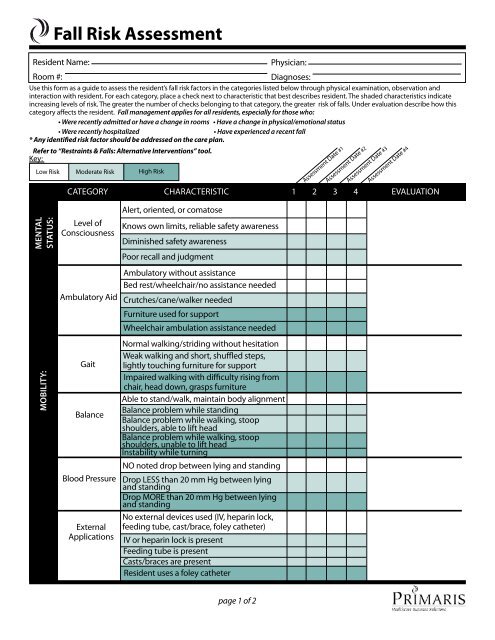The Dementia Fall Risk PDFs
Table of ContentsThe Ultimate Guide To Dementia Fall RiskDementia Fall Risk Fundamentals ExplainedDementia Fall Risk - TruthsA Biased View of Dementia Fall Risk
A loss threat assessment checks to see exactly how most likely it is that you will certainly drop. The analysis usually includes: This includes a series of concerns regarding your total wellness and if you have actually had previous falls or problems with balance, standing, and/or walking.STEADI consists of testing, analyzing, and intervention. Interventions are referrals that may lower your risk of falling. STEADI includes three steps: you for your risk of falling for your risk elements that can be boosted to try to avoid falls (as an example, balance problems, impaired vision) to reduce your risk of falling by using effective techniques (as an example, offering education and resources), you may be asked several questions including: Have you dropped in the previous year? Do you feel unsteady when standing or walking? Are you stressed over dropping?, your provider will certainly examine your toughness, equilibrium, and gait, using the adhering to loss evaluation tools: This test checks your stride.
If it takes you 12 secs or more, it may suggest you are at higher threat for a fall. This test checks toughness and equilibrium.
Move one foot halfway ahead, so the instep is touching the large toe of your other foot. Move one foot totally in front of the other, so the toes are touching the heel of your other foot.
Our Dementia Fall Risk Diaries
The majority of falls happen as a result of several contributing factors; therefore, managing the threat of dropping begins with recognizing the variables that add to fall risk - Dementia Fall Risk. Several of one of the most appropriate risk factors consist of: History of prior fallsChronic clinical conditionsAcute illnessImpaired gait and balance, reduced extremity weaknessCognitive impairmentChanges in visionCertain risky medicines and polypharmacyEnvironmental elements can also raise the danger for falls, consisting of: Poor lightingUneven or damaged flooringWet or unsafe floorsMissing or damaged handrails and order barsDamaged or poorly fitted tools, such as beds, mobility devices, or walkersImproper use assistive devicesInadequate guidance of individuals living in the NF, consisting of those who show aggressive behaviorsA successful loss danger management program requires a comprehensive scientific assessment, with input from all participants of the interdisciplinary team

The care strategy should additionally include treatments that are system-based, such as those that promote a safe atmosphere (appropriate lights, handrails, order bars, wikipedia reference etc). The effectiveness of the treatments should be examined periodically, and the treatment plan changed as required to mirror changes in the autumn threat evaluation. Applying a fall danger management system utilizing evidence-based ideal practice can minimize the occurrence of falls in the NF, while restricting the potential for fall-related injuries.
The smart Trick of Dementia Fall Risk That Nobody is Discussing
The AGS/BGS guideline recommends screening all adults aged 65 years and older for fall risk yearly. This testing consists of asking patients whether they have fallen 2 or even more times in the past year or sought medical interest for an autumn, or, if they have not fallen, whether they feel unsteady when strolling.
Individuals who have fallen once without injury should have their balance and gait evaluated; those with important site stride or equilibrium problems need to obtain added analysis. A history of 1 fall without injury and without gait or equilibrium troubles does not necessitate more analysis beyond continued yearly autumn danger screening. Dementia Fall Risk. A fall threat analysis is needed as part of the Welcome to Medicare examination
.png)
The Basic Principles Of Dementia Fall Risk
Recording a falls background is one of the top quality indicators for loss prevention and administration. A crucial part of risk evaluation is a medicine evaluation. Numerous classes of medicines raise fall danger (Table 2). copyright medications specifically are independent predictors of falls. These medicines tend to be sedating, change the sensorium, and harm equilibrium and gait.
Postural hypotension can usually be reduced by minimizing the dose of blood pressurelowering drugs and/or stopping medications that have orthostatic hypotension as a side effect. Usage of above-the-knee assistance hose pipe and sleeping with the head of the bed boosted may also minimize postural decreases in blood stress. The preferred elements of a fall-focused physical exam are displayed in Box 1.

A find out here Yank time higher than or equal to 12 secs suggests high loss danger. Being incapable to stand up from a chair of knee height without utilizing one's arms shows enhanced loss danger.